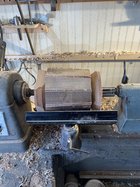Posting this from the 'if it does not feel right, ask dept'. I've got a few staved vessels ready to turn, and wanted some advice about if using a skew on them is a good idea or not. In the last year or so, I turned a few of these larger vessels but used roughing gouges and probably bowl gouges. Since then, I've spent a lot of time becoming comfortable with a skew, and thought it would be good to use on the outside of these. However, as I sized things up, I did not feel comfortable with the tool rest position being approximate at center point, as it did not allow it to be presented across the top of the turning as I do for thinner spindles. In order to cut, the skew has to be more vertical and it did not seem to want to be close to a 45* angle, instead more like 70* or so.

Here is an example of the size and type of vessel I'm working with, note the picture is angled such that the tool rest looks super low, but in fact it is at center line.
It seems like a taller toolrest would help as the skew could then be in a more comfortable horizontal plane, as it is for smaller diameter spindles. If so, that is an easy problem to solve, but if it turns out that it is a bad idea, I can forgo using the skew and go back to gouges for this. Curious to the experiences of others.

Here is an example of the size and type of vessel I'm working with, note the picture is angled such that the tool rest looks super low, but in fact it is at center line.
It seems like a taller toolrest would help as the skew could then be in a more comfortable horizontal plane, as it is for smaller diameter spindles. If so, that is an easy problem to solve, but if it turns out that it is a bad idea, I can forgo using the skew and go back to gouges for this. Curious to the experiences of others.
